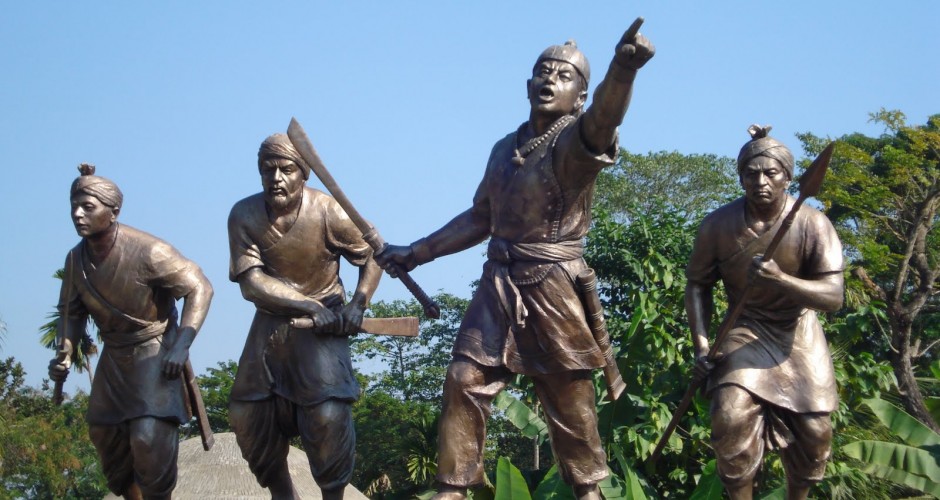The Hindu Civilsation has given birth to many sages and warriors over its long history to survive and this is a short story of one of its greatest sons mostly known only within Assam but unknown sadly among most Hindus themselves..
In the mid 1600s the Mughal Empire was in the noontide of its glory – one of the greatest and largest empires in the world with a power army to match it. By force and conciliation it had overrun a large part of India before their fanatical policies of religious persecution led to a series of uprisings and revolutions that brought the entire empire crashing into the dustbin of history.
The event which is regarded as the keynote defeat of Mughal armies and the beginning of the fall of the Mughal Empire was the victory of the greatest Assamese Hindu warrior, Lachit Borphukan, who defeated the Mughals in the historic battle of Saraighat in April 1672.
 The Mughal Emperor sent his greatest general, Mir Jumla, to conquer the land of Assam which was ruled at that time by the Hindu Ahoms. This valiant tribe had repulsed numerous attacks on their homeland from the time of Muhammad Ghori to the present, defeating no less than seventeen invasions.
The Mughal Emperor sent his greatest general, Mir Jumla, to conquer the land of Assam which was ruled at that time by the Hindu Ahoms. This valiant tribe had repulsed numerous attacks on their homeland from the time of Muhammad Ghori to the present, defeating no less than seventeen invasions.
A desperate fight ensued in the jungles and the valleys where the people rallied by Lachit Borphukan and the Hindu monks of the land in a war of liberation.
From the capital city of Guwahti to the depths of the forests the Ahoms fought and held back the tide of invasion. The proud warriors of Central Asia, Mughal and Pathan alike were foiled by the valiant resistance of the Ahoms.
Apart from being the headquarters of the Mughal Governor in occupied Ahom territory, Guwahati had great strategic importance. The Brahmaputra river between Kamakhya and Saraighat is the narrowest at Guwahati and there are hills on both banks of the river in this area.
The area was densely forested and road communications were very poor. The Brahmaputra waterway was the most important line of communication. A large army moving in this region had to make use of the Brahmaputra waterway. Lachit first struck at Bargoda fort at the junction of Bar Nadi and the Brahmaputra.
The Mughal garrison was driven out from this fort and their counterattacks defeated. The Mughal reserves came up to the north bank and prevented further Ahom advance but could not dislodge them from Bargoda. Lachit Borphukan now shifted his attention to Sukreswar hill on the south bank where the Mughals had a fort, which was also the headquarters of the Mughul Governor. Ahom commandos managed to infiltrate the fort and neutralised the cannons by pouring water through their mouths and over their stock of gunpowder.
This was followed by a heavy cannonade by the Ahoms and a determined assault of the fort. Sayed Firoz Khan, the governor, was taken a prisoner. The Mughals abandoned Guwahati. Lachit Barphukan now advanced down the Brahmaputra to Manas recovering all the Ahom territory ceded to Mir Jumla. A stone victory pillar in the Guwahati museum has an inscription in Sanskrit praising Lachit Barphukan for his great victory against the Mughals.
An incident in the history of the Hindu Ahom resistance marks the spirit which animated their fight for freedom, when Lachit Borphukan, the Army General of Ahom king Chakradhwaj Singha had beheaded his maternal uncle for dereliction of duty while preparing to face the Mughals. His execution of his own uncle for not showing sufficient dedication to the war effort was not just an act of impulse but a reminder to his soldiers that in the service of one’s Dharma, it is not possible to adopt double standards of judgement.
Historians may have neglected Assam but history has not. History text books give details of the Indus Valley civilisation, the Ganges Valley civilisation and the Mughals, the British etc but they hardly mention the Brahmaputra Valley civilisation, when the history of Assam is unique. Unlike some Indian states, Assam did not succumb to the invasions of Delhi Sultans of Mughal Emperors and bloodthirsty tyrants and are a reminder of the preservation of freedom of thought and culture – the keystone of Hindu Dharma
Hindu Dharmashãstras have enjoined upon every Hindu to repay according to his or her capacity the rishi-riNa, that is, the debt we owe to our seers and sages, by passing on to the next generation the Veda and the Itihãsa-PurãNa, that is, the spiritual and cultural vision of Sanatana Dharma and the historical tradition of Hindu heroism… : Sita Ram Goel





































I would love to read all your posts. Thanks Regards.
I found your website today only. I have not read your any post fully. I liked them. will read them fully later. will comment later. But I fully agree with your posts.